A neonate with scalp rash, hair loss
A 3-week-old female neonate returns to your office 1 week after her normal 2-week well-baby visit with a rapidly progressive rash on her scalp. The rash and some loss of hair were first noticed a few days earlier, and both conditions appear to be rapidly progressive. She has had no fever, change in appetite or behavior. Her medical history includes a normal pregnancy, labor and delivery and normal first 2 weeks of life. All routine prenatal testing was normal or negative. There are no other complaints.

James H. Brien
Her family history is positive for three older siblings, all of whom currently have some degree of “ring worm” (tinea corporis). There has been exposure to family cats, but no other animals or sick contacts.
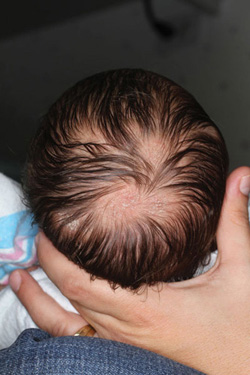
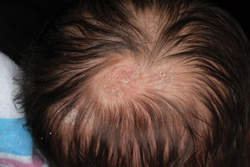
Figures 1-3. A healthy 3-week-old infant is seen with some patchy alopecia along with some scaling and inflammation of the involved skin.
Source: Brien JH

Figure 3.
Examination reveals a healthy 3-week-old infant with some patchy alopecia along with some scaling and inflammation of the involved skin (Figures 1-3). The rest of her exam is normal. There were no pre-visit lab tests. A scraping of the inflamed scalp and some hairs plucked for fungal culture is pending.
What’s Your Diagnosis?
A.Neonatal candidiasis
B.Microsporum canis
C.Malassezia furfur
D.Incontinentia pigmenti
Case Discussion
This is a rare case of neonatal tinea capitis. The dermatophyte recovered was Microsporum canis (B), the second most common cause of tinea capitis after Trichophyton tonsurans. Therefore, I had to leave it off the list to have the correct answer in this case on the list. There’s no good reason why newborns should not get infected with these dermatophytes except for a lack of close contact with an infected person or animal. They just seem to be better protected than most of our older patients. In fact, there was a report of an outbreak of six cases in a level II NICU (Snider R. Pediatr Infect Dis J. 1993;12:145-148.) that was traced back to a single provider. The findings are the same as in older children; alopecia with inflamed, scaling scalp, possibly with some pustular or occasionally nodular lesions.
The above patient was empirically treated with oral griseofulvin at a dose of 15 mg/kg to 20 mg/kg once daily for 4 weeks with monitoring for liver toxicity. The baby showed rapid improvement by 2 weeks. The recommended dosing ranges from 10 mg/kg to 40 mg/kg as a daily dose or divided into two doses, from 10 days to 4 weeks, depending on severity and who you read.
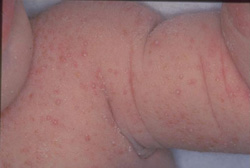
Figure 4. Pellentesque quis est ut dui tincidunt laoreet eu non felis. Suspendisse pharetra hendrerit metus, eu luctus mi tincidunt sed. Pellentesque fringilla auctor mauris, tincidunt tincidunt lorem lobortis cursus. Lorem ipsum dolor sit amet, consectetur adipiscing elit. Integer commodo placerat fermentum.
The AAP Red Book dose is 10 mg/kg to 20 mg/kg per day in two doses. Nelson’s Pediatric Antimicrobial Therapy 2012-2013 edition gives a range of 10 mg/kg to 25 mg/kg as a single dose in the child beyond the neonatal period, with no mention in the neonatal section. Remington and Klein’s Textbook of Infectious Diseases of the Fetus and Neonate, 7th edition recommends 10 mg/kg/day to 40 mg/kg/day as single daily dosing.
Clearly, neonatal dosing is not well established, so I took my guidance from the above article and one by William Weston, MD, (with whom I rotated as a resident 30 years ago) of the departments of dermatology and pediatrics at the University of Colorado School of Medicine in Denver. Weston reported a case of pustulonodular tinea capitis in a 5-week-old (Weston WL. Pediatr Infect Dis. 1998;17:257-258.) treated with 20 mg/kg/day with rapid improvement. Additionally, monitoring liver function is also not uniformly recommended in healthy infants.
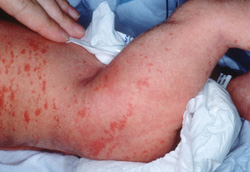
Figure 5. The rash appeared as streaks of various-sized blisters, vesicles and pigment that orient along the lines of Blaschko.
Neonatal candidiasis typically presents a few days after delivery through an infected or colonized birth canal. The skin usually has numerous papules and pustules on narrow erythematous bases (Figure 4). The contents of a pustule can be examined with a KOH prep to see the budding yeast and pseudohyphae. There may be some overlap in the appearance of lesions on the scalp, but there would not be much scaling expected with candidiasis, and extension beyond the scalp would not be likely with tinea capitis.
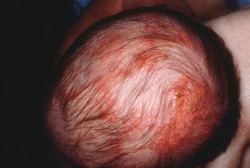
Figure 6. In the scalp, the rash may appear in a whorl pattern.
Malassezia furfur is the cause of tinea versicolor, a flat rash with patches of various sizes and shades of pigment under a fine scale. Diagnosis can be made with a KOH prep revealing the hyphae and spores that have a “meatballs and spaghetti” appearance. Treatment can be with a variety of topical antifungals as well as 2.5% selenium sulfide.
Incontinentia pigmenti is an X-linked dominant neurocutaneous syndrome with four distinct phases. In the newborn, the rash appears as streaks of various-sized blisters, vesicles and pigment that orient along the lines of Blaschko (Figure 5). In the scalp, the rash may appear in a whorl pattern (Figure 6) and, except for that, may appear similar to tinea capitis. But the whirling pattern and distinctive features of the rest of the rash should make differentiating easier. There is no treatment; just management of complications.
Columnist Comments
It’s that time of year for Halloween. Think about posting safety tips for parents of children who will be out for Halloween. This holiday seems to always bring out people who want to hurt children; plus a variety of other hazards, such as darkness, traffic, unsafe costumes, etc, can add to the danger. Another idea is to mail along a simple sheet of tips with the bills. An excellent resource can be found at www.cdc.gov/family/halloween. Just go to the printer-friendly version.
Also, you should be getting your patients immunized for influenza this time of year, especially those high-risk children. A list of high-risk patients can be found at another CDC site: www.cdc.gov/flu/about/disease/high_risk.htm.









